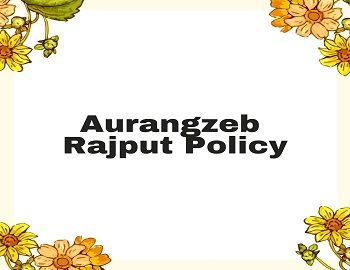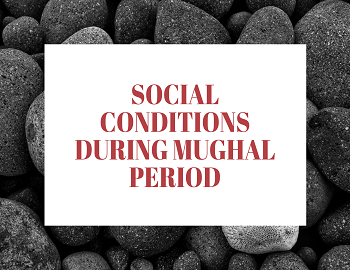Table of Contents
Aurangzeb Rajput Policy:
Traditional View:
According to this view with the help of Rajputs Akbar created a big empire but due to wrong policy, Aurangzeb became instrumental behind the disintegration of that empire. Aurangzeb did not simply lose the support of Rajputs but also fell in a long war with them. In fact, he followed a tough policy towards Jodhpur when he intervened into the matter of succession. After the death of the ruler of Jodhpur, Jaswant Singh, he arbitrarily declared Inder Singh, a nephew of Jaswant Singh, the ruler of Jodhpur, in return of 30 lakhs rupees. So he picked up quarrels with Rathors of Jodhpur who under the leadership of Durga Das refused to accept Inder Singh as their ruler. Then the cause of Rathors was supported even by Sishodias of Mewar under Rana Raj Singh who took the right of succession as the dearest privilege of Rajput states.
So Aurangzeb got involved into a devastating and useless war with Rajputs. The pathetic side of the picture was that Aurangzeb fell in a war with such a force with the help of which he could have the effective control over the subversive forces in Deccan. Above all, the damage done by the conflict with Rajputs should not be calculated merely in terms of loss of soldiers and money but rather it should be calculated very rationally.
In fact, this war questioned the sagacity of Aurangzeb and his officers in policy-making and proved that they were not competent to run the government of Hindustan. This episode created distrust and suspicion among different groups and encouraged conspiracies in which even Mughal princes participated.
New Approach:
It is not rational to assert that Aurangzeb reversed the Rajput policy of Akbar. On the contrary, he continued the policy of befriending Rajputs. For example- right from the period when Raja Man Singh was recalled from Bengal, no Rajput Mansabdar had so far been made the Subedar of any province earlier to the period of Aurangzeb. It was Aurangzeb who appoint Mirza Raja Jai Singh and Jaswant Singh on the post of Subedar or Nazim in spite of the fact that both these Rajput nobles had participated in the war of succession on behalf of Dara Shikoh.
Secondly, the conflict between Aurangzeb and Rajputs should not be taken as the result of his religious orthodoxy for the fact that the number of Hindu mansabdars increased sharply under Aurangzeb. It reached up to 33% of the total number of Mughal Mansabdar. Although it is true that during his rule, in comparison to Rajputs, Marathas were appointed in greater number it was due to the fact that Aurangzeb was seeking the local support in his war against Marathas.
Likewise, the case of Jodhpur was not a single example of Mughal intervention in the matter of Rajput succession. We find such a case even earlier than Aurangzeb’s period. For example- even under Akbar there was some intervention in the succession of Jodhpur. Furthermore, Jahangir intervened into the succession matter of Bikaner and Amber.
Likewise, the impact of the conflict with Rajputs should not be overestimated. Although Aurangzeb for time being lost the support of Rathors and Shisodias still he was enjoying the support of Rajput states like Amber, Ranthambore, Bundi and Kota.
Furthermore, from 1681 onwards when Shisodias under Rana Jagat Singh withdrew from this conflict and established peace with Aurangzeb the military involvement of the Mughal empire in the context of Rajputs became much limited. So, it is not justified to say that the conflict with Rajputs adversely affected the trade route leading up to the northwest.
- Partition of Bengal (1905)
- The Morley-Minto Reform or the Indian Council Act 1909
- The Home Rule League, 1916
- Montagu Declaration or August Declaration [1917]
- Montagu-Chelmsford Reforms or the Government of India Act 1919
- Rowlatt Act, 1919
- Jallianwala Bagh Massacre [April 13, 1919]
- Popular resistance to company rule– NIOS









Comments (No)